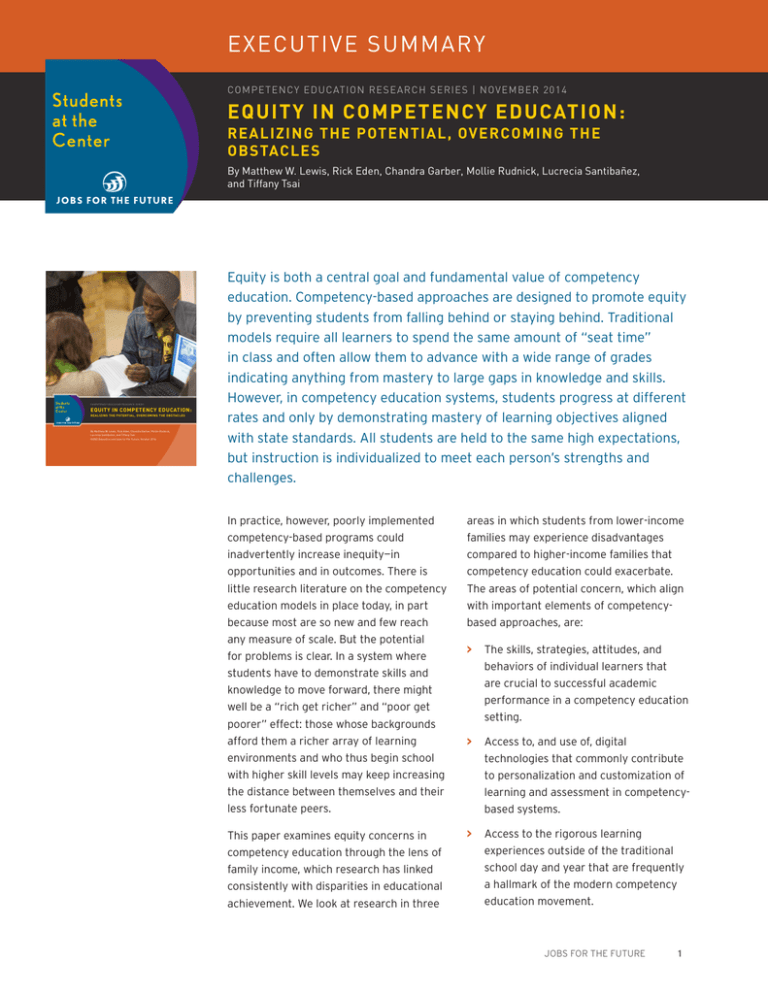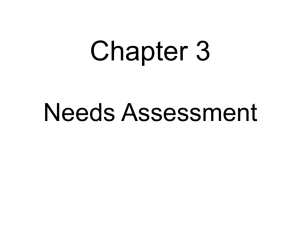EXECUTIVE SUMMARY EQUITY IN COMPETENCY EDUCATION: REALIZING THE POTENTIAL, OVERCOMING THE OBSTACLES
advertisement

EXECUTIVE SUMMARY COMPETENCY EDUCATION RESEARCH SERIES | NOVEMBER 2014 EQUITY IN COMPETENCY EDUCATION: REALIZING THE POTENTIAL, OVERCOMING THE OBSTACLES By Matthew W. Lewis, Rick Eden, Chandra Garber, Mollie Rudnick, Lucrecia Santibañez, and Tiffany Tsai COMPETENCY EDUCATION RESEARCH SERIES EQUITY IN COMPETENCY EDUCATION: REALIZING THE POTENTIAL, OVERCOMING THE OBSTACLES By Matthew W. Lewis, Rick Eden, Chandra Garber, Mollie Rudnick, Lucrecia Santibañez, and Tiffany Tsai RAND Education and Jobs for the Future, October 2014 JOBS FOR THE FUTURE i Equity is both a central goal and fundamental value of competency education. Competency-based approaches are designed to promote equity by preventing students from falling behind or staying behind. Traditional models require all learners to spend the same amount of “seat time” in class and often allow them to advance with a wide range of grades indicating anything from mastery to large gaps in knowledge and skills. However, in competency education systems, students progress at different rates and only by demonstrating mastery of learning objectives aligned with state standards. All students are held to the same high expectations, but instruction is individualized to meet each person’s strengths and challenges. In practice, however, poorly implemented competency-based programs could inadvertently increase inequity—in opportunities and in outcomes. There is little research literature on the competency education models in place today, in part because most are so new and few reach any measure of scale. But the potential for problems is clear. In a system where students have to demonstrate skills and knowledge to move forward, there might well be a “rich get richer” and “poor get poorer” effect: those whose backgrounds afford them a richer array of learning environments and who thus begin school with higher skill levels may keep increasing the distance between themselves and their less fortunate peers. areas in which students from lower-income families may experience disadvantages compared to higher-income families that competency education could exacerbate. The areas of potential concern, which align with important elements of competencybased approaches, are: This paper examines equity concerns in competency education through the lens of family income, which research has linked consistently with disparities in educational achievement. We look at research in three >> Access to the rigorous learning experiences outside of the traditional school day and year that are frequently a hallmark of the modern competency education movement. >> The skills, strategies, attitudes, and behaviors of individual learners that are crucial to successful academic performance in a competency education setting. >> Access to, and use of, digital technologies that commonly contribute to personalization and customization of learning and assessment in competencybased systems. JOBS FOR THE FUTURE 1 We recognize that family income is just one of many factors that can lead to inequities in educational achievement. Other groupings, such as those based on race, ethnicity, gender, disability, and English language fluency, may be important; but the available research base using these constructions is not sufficiently nuanced for our purposes. Limited research and mixed results exist when examining the connections between, and differences within, income levels in regard to academic perseverance. Regardless of what current or future research indicates, it is important to note that good evidence exists showing that these particular learning strategies are, in fact, teachable. LEARNING STRATEGIES AND PERSEVERANCE DIGITAL ACCESS AND USE In order to succeed in a competency-based program, students require certain skills, strategies, attitudes, and behaviors. These range far beyond logical-mathematical reasoning abilities; they also involve self-perceptions, internal regulation, emotional states, drives, motives, and the ability to make meaning out of a variety of social situations in classrooms and schools. We focus on two areas that may be of significant relevance in competency education: >> Learning strategies identified as “metacognitive strategies” and “self-regulated learning,” which students need in order to acquire complex knowledge and skills, especially in classrooms that rely less than traditional classrooms on direct instruction. >> Academic perseverance, which students need in order to maintain focus and drive in the face of challenges. Within a competency education context, learning strategies play a role in a student’s ability to attain new skills and content knowledge, progress at an individual pace, and benefit from customized support. Metacognitive strategies and self-regulation provide students with the skills to selfreflect and adjust their own behaviors as needed. However, research suggests that there are differences between lower- and higher-income learner groups in attaining metacognitive skills and in demonstrating selfregulation. Ultimately, these differences can negatively affect student success, particularly in a competency education classroom where the abilities to understand one’s own thinking process and to self-regulate play a critical role. Academic perseverance plays an important role in any student’s educational success. Within the context of competency education, however, academic perseverance becomes essential. The ability of students to progress at their own pace requires a certain degree of ownership and determination that may not be as necessary in a more traditional, teacher-led classroom. 2 Although the digital divide is decreasing, it is still present. Consequently, access to and the use of technology—in schools and communities, in the home, and by individual students—is a critical element to understanding whether and how inequities would interfere with student achievement in competency-based models. The literature and data discussed in the paper suggest legitimate concerns regarding differences in digital access potentially exacerbating inequities in learning achievement between low- and high-income students in competency education environments. For example, high-income schools not only have greater access to state-of-the-art digital tools when compared to low-income schools, they are also more likely to promote higher-order thinking skills using these technologies, such as teaching analysis using spreadsheets. At home, the availability of technology, as well as how families (and parents in particular) view the educational benefits of technology, students’ skills and effectiveness interacting and using technology, and the time students spend interacting with technology all vary based on income levels of a household. ACCESS TO LEARNING CONTENT AND EXPERIENCES The quality of learning content and experiences to which students have access outside of the school day and traditional year can make a difference in achievement regardless of the student’s primary educational setting. But this factor may be particularly important to students in competency-based programs, especially those that offer opportunities to acquire skills and knowledge, demonstrate competency, and earn recognized credit outside of the classroom. Supplemental learning materials, tutoring, afterschool programs, informal learning environments (e.g., art and science museums, camps), and even web-based materials COMPETENCY EDUCATION RESEARCH SERIES | EQUITY IN COMPETENCY EDUCATION and tutoring each have the potential to be more easily accessible to higher-income students. Differences in income could have significant impacts on the financial resources available to provide access to these supplemental learning materials and experiences, as well as adult caregiver time to identify opportunities and provide transportation. MITIGATIONS TO ADDRESS EQUITY CONCERNS In order to realize the potential of competency education, it is essential to confront concerns that competency-based approaches could inadvertently exacerbate educational inequities or create new ones. Research suggests that educators in competency education systems who want to mitigate the effects of poverty on student achievement can take specific steps to reduce or eliminate some factors that create inequity. The full paper discusses these strategies in detail. We summarize some of the possible interventions in the table below: Other means to address equity concerns in competencybased systems are certainly available and possible. This paper necessarily relied on educational research that looks at core elements often found in competency education but not on competency education specifically. Further research should focus not only on its overall effectiveness, but also on the potential differential effects on different student populations, so that the field can “get out in front” of possible inequities and reduce the risk. Many in the competency education community believe that, over time, competency-based approaches—when effectively implemented—will narrow existing achievement gaps. As efforts to develop, implement, and understand the impact of competency education grow, it is important for program designers, administrators, teachers, and policymakers to pay concerted attention to equity issues, so that all students, and lower-income students in particular, receive the customized supports that competency education models are designed to provide. Possible Mitigations to Address Learning Inequities in Competency Education Topic Metacognitive learning strategies Self-regulation skills Possible Mitigations >> Use individual tutorials to diagnose gaps in metacognitive learning strategies and explicitly teach such skills, within the context of the material the student is learning. >> Students in collaborative, heterogeneous, small-group settings help peers by providing examples of such skills, and prompt fellow learners to apply these skills. >> Teachers explicitly teach self-regulation skills, such as positive “habits of mind,” in the context in which the skills are applied. >> Schools and districts emphasize the ability to develop students’ academic perseverance. Technological access >> Districts and teachers provide learners with early and continued access to technologies and experiences that enable use of higher-level cognitive skills. Access to learning experiences outside of school >> States, counties, districts, for-profits, and nonprofits make available affordable, high-quality afterschool programs and clubs, as well as summer learning opportunities. JOBS FOR THE FUTURE 3 C O R P O R AT I O N Jobs for the Future works with our partners to design and drive the adoption of education and career pathways leading from college readiness to career advancement for those struggling to succeed in today’s economy. We work to achieve the promise of education and economic mobility in America for everyone, ensuring that all low-income, underprepared young people and workers have the skills and credentials needed to succeed in our economy. Our innovative, scalable approaches and models catalyze change in education and workforce delivery systems. Students at the Center—a JFF initiative—synthesizes and adapts for practice current research on key components of student-centered approaches to learning that lead to deeper learning outcomes. Our goal is to strengthen the ability of practitioners and policymakers to engage each student in acquiring the skills, knowledge, and expertise needed for success in college, career, and civic life. This project is supported generously by funds from the Nellie Mae Education Foundation and The William and Flora Hewlett Foundation. The RAND Corporation is a research organization that develops solutions to public policy challenges to help make communities throughout the world safer and more secure, healthier and more prosperous. RAND is nonprofit, nonpartisan, and committed to the public interest. WWW.RAND.ORG STUDENTSATTHECENTER.ORG WWW.JFF.ORG This report was funded by the Nellie Mae Education Foundation. The full report is available at www.studentsatthecenter.org/equity-in-ce






